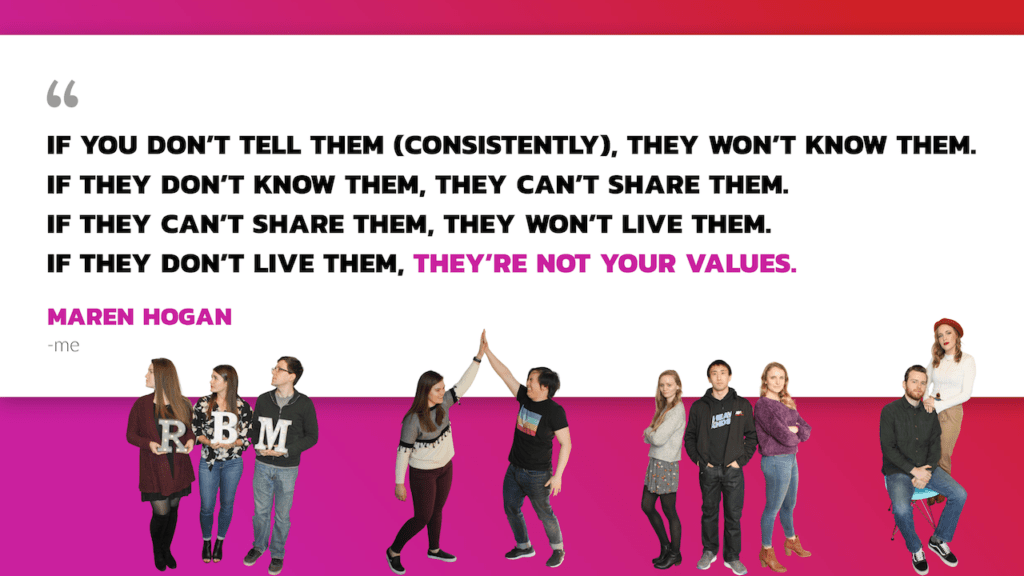Synopsis: Hiring to your values is impossible if you don’t have employee buy-in. Here’s how to survey, get employee feedback, manage, recruit and hire to your values.
Values are the lifeblood of your business. They impact everything your business does. Before your values can impact anything, they need to be identified. It isn’t as easy as having a meeting with your executives. That wouldn’t be authentic.
What you want is to have your employees buy-in to your values. In some cases, they might even help you identify some in the first place. The real question here is this:
Values are the lifeblood of your business, so how can you get your employees to buy into your values? @Marenhogan's latest @RedBranch article has tips you NEED to hear: Share on X“How do I get my employees to buy into our values?”
To Identify Your Values, You’ll Need to Get Sherlock Holmes About It
We’ve worked with clients in days past who had different values for each different type of worker (blue-collar, white-collar, etc.). In our own house, things weren’t much better. We had seven values in the employee handbook, nine on the website, and eleven in our internal steering committee documents. Yikes.
Here’s how we broke it down at Red Branch Media:
First, we wrote out all our values from each disparate source on a whiteboard.
Next, we defined each one and an example of how that value would play out in our daily business.
Here’s an example: We defined Resilience as always getting back up after being knocked down. We saw this in Eric as he worked with a troublesome account and wasn’t making progress. He didn’t stop. Eventually, the numbers did start going up, and with startling trajectory.
Third, we drew lines between the ones that were similar in both definition and application. In our case, it was Brutal Honesty and Transparency. We combined the values that were similar into one value that encompassed both ideas.
For us, Brutal Honesty and Transparency turned into Brutal Transparency.
The fourth step is simple: Pare down! When you have lots of values, it can be tough for even the person who identified the value to remember them all. For your own sake, and for the sake of your employees, pare your values down so anyone in the company can recite them. The ideal range is no less than 4 and no more than 10.
Coco Chanel was said to have advised the following when dressing with accessories:
“Before you leave the house, look in the mirror and take one thing off.”
The same should hold true for your values.
While you can include most members of the team or workforce (especially if it’s a small one), for many you’ll need to do the first part with a smaller team to avoid “too many cooks in the kitchen”.
Here’s my full presentation on this subject:
Survey for Value Statements and Cut Through the Noise
To ensure you have a finger on the pulse of the organization, select an employee advocate from each area of the business. While some of these advocates can be in management, try to select those at varying levels of seniority.
Do:
-
- Select a diverse pool of employees
- Have managers, executives, and front-line workers
- Select white-, grey-, and blue-collar employees
- Add people who have been with the company for 5+ years
- Ensure anonymity and respect for their time
- Have someone from each department or team
- Include every region if you are global/national
- Ask trusted clients, partners, or customers when appropriate
- Make all surveys mobile
Don’t:
-
- Select employees for the sake of being diverse
- Only include HR and Execs in the process
- Have more than 2-3 people with <6 months of experience in the company
- Request more than 15 minutes of their time each week
- Only survey “skilled workers”
- Focus only on one area/region/department
- Share controversial opinions with anyone but your HR team
With this group, you can create a quick survey to get a sense of whether or not your values are on the mark. Survey this group using a simple survey (use SurveyMonkey or GoogleForms) on a weekly cadence to help refine this list.

Here’s a simple structure you can follow:
- Rate/Rank the Values in order of importance in general.
- For each value, ask if they agree with the definition and application (I do not recommend separating these). (Use the strongly agree/strongly disagree scale but don’t include N/A or neutral as options.)
- Ask if they believe (given the definition provided) that each value reflects the company at large. (Use Yes/No option.)
- Ask if they believe that each value reflects the team or person they work with every day. (Use the strongly agree/strongly disagree scale but don’t include N/A or neutral as options.)
- Ask which person at the company represents each value. Include the option “I can’t think of one/identify one.” (Use Open Text and an additional optional box “Why?”)
- Ask them to select the three values, in order, that best reflect them. (Radio boxes, allow only three to be selected.)
- Finally, ask if they can think of an example of how THEY themselves exemplify their top 3 values. (Open Text)
After doing this for seven weeks, you should have a pretty comprehensive view of how your company as a whole views the values, if they are lived out throughout the enterprise, and finally if they have been individually internalized.
You may also have some values that you thought were accurate but your survey shows are not at all. This does not mean you have to throw them away! You should put those identified as least representative toward the bottom while moving those that were rated strongly agree and had numerous examples up higher.
Keep these rankings in mind and moving forward, rank your values in this order for now. You also may have some great employee-sourced value statements sourced. Hold onto these. You’ll need them later.

Infuse Company Communications & Events With Values to Reinforce Their Importance
Now, hopefully, your employee advocates are willing to start spreading the word. Even if they aren’t, it’s time to whip out that old marketing hat and start getting people excited about the values. Why?
“If you don’t tell them (consistently), they won’t know them. If they don’t know them, they can’t share them. If they can’t share them, they won’t live them. If they don’t live them, they’re not your values.”
-Maren Hogan
Your first step before any of this is to create a company-wide email workflow with your refined values. You may add your anonymous survey to the end of each email but do not require a response.
Don’t have TIME to write 7 emails? I DO! Here is a sample workflow you can download from our resource library! Follow the link to learn more about how we can help YOU!
After 7 emails and 7 surveys, your employees should have internalized at least the definitions. You and I both know that many employees will be too busy or not care enough to fill these out. But the ones who DO are the ones you want internalizing those values anyway.
Here are just a few practices you can implement right away:
- T-shirts…Yes, I totally sold this as “beyond t-shirts” but you guys, t-shirts are fun. Plus values are usually 1-2 words and inspiring and it’s better than ANOTHER logo polo
- Mugs. Coffee mugs are the lifeblood of a lot of offices. For the rest of you…water bottles
- Posters. Ask a designer if they’d create a simple series of posters with your values
- Do you have a recognition and rewards program? Insert values as a lever to press. “You are the grittiest Brancher” has been said in our office
- Put values into performance conversations, management systems, and reviews.
- Put values into all job descriptions, career site copy, FAQs, email communiques and advertisements
- Have a values section on your intranet
- Put your values on your website (if you can)
- Create notepads with the values on them
- Have employees write a blurb on what each value means to them, then use them in blog posts.
- Have managers center their continuous feedback or meetings around a value
- Regularly use values on social media posts, with pictures if possible
Create a Value-Based Hiring and Performance Process
The next question you’re probably asking yourself is “How do I get my employees to buy into our values?
Managing and hiring to your values go hand in hand. While not every employee will identify strongly with each value (for example, I am the WORST at Balance) they should all know they had a hand in selecting, defining and refining them. They have also been challenged to go through each value and see how it plays out in the people and culture around them.
 Firstly, your values and their definitions have to be part of the company vernacular. Chances are you’ve spent some serious coin on developing an EVP and employer brand. If not, I am sure you poured blood, sweat, and tears into the damn thing. So leverage that spend and effort into getting your values INTO performance conversations.
Firstly, your values and their definitions have to be part of the company vernacular. Chances are you’ve spent some serious coin on developing an EVP and employer brand. If not, I am sure you poured blood, sweat, and tears into the damn thing. So leverage that spend and effort into getting your values INTO performance conversations.
If you can, get the values into your performance management system. If not, then recognition/rewards and/or culture and engagement. All 3? Awesome!
If employees can self-rate their use and implementation of the value, and managers/supervisors/colleagues can as well, they are more likely to spot instances where it’s being used properly and more able to start conversations more easily when someone is violating a core value.
Introduce values into both constructive and corrective feedback, as well as praise statements. Train your executives first, directors next, managers, and then all employees. It’s a lot easier to say:
“Hey the way you just responded to your coworker in that meeting didn’t exactly promote harmony on the team. Is something going on? I think it made Karen feel dejected.”
It’s also great to hear:
“Hey Josh you really lived out our Pursuit of Excellence value with that client. Way to go.”
It’s specific and in a language we’ve all agreed upon.
Read More: Creating a Company Culture Your Employees Can Get Behind
And Finally, Hiring to Your Values
Adding your values to your hiring process starts at the very beginning. If you have a sourcing and recruitment or TA function, you need to ensure your employees are using values when they assess people.
DYK: 90% of candidates won’t work for a company that doesn’t align with their values? This can be as simple as looking for a word match and be as complex as having a version of your values in your interviewing process.
When Buffer was just 10 people, it noticed that 80% of Fortune 100 companies expressed their values publicly and that purpose-driven companies outperform others by 40%.
Link your values to behaviors.
What do these behaviors look like? This can really help you narrow down your values into what’s real and what is idealistic. Make a list of 5-10 behaviors, actions, or achievements that embody each core value.
Your values should be in your job descriptions.
This really isn’t optional. Because job descriptions are usually internal, I encourage you to select examples from your survey as “values in action”. Having Balance as a value is great, but in speaking with my employees and viewing some of their submissions to our blog or video ideas, I realized it means different thing to different Branchers in different roles.
Your values should be in your job advertisements.
If you are constricted by space, direct people to the overall values section or have a career site page dedicated to it. TIP: If you can interlink these in your career site, your MVV statements, or your employee referral platform, do it!
For example, if you establish respect and positivity as two of your core values, these should appear in all of your job adverts––regardless of job title or department.
Your values should be reflected in your assessments and screening process.
If you use any screening methods, including phone screens, see how many value-based Qs you can add in. It could be as simple as having the screening service or person list the values and let the candidate know they’ll be important for the interview.
Assessments in your hiring process are super great places to start discussing values. There are many science-based assessments and quiz apps on the market that can help you determine if a candidate and your values-based culture are a match.

Your values should be in your interviewing and candidate scoring process.
Asking a candidate directly about their values is the obvious choice, but they could be telling you what you want to hear. Instead…
Ask values-focused behavioral interview questions.
You already know your values and have your values in action. You even have examples of your values in people who work there. So ask questions based on these. You can also identify the opposite of your values and ask questions or seek insights about those. Some great follow up questions to get more insight into their real values include:
- What did you learn from this experience?
- Would you have done anything differently and if so, what?
- What did you learn about problem-solving from this experience?
- What were the consequences of this decision?
- What was the impact of this decision?
When I work with companies to create a value-based hiring process, I help them create a scorecard that lists each value with an accompanying question to identify it. Most companies pepper these throughout the interview rather than drilling them all at once.
Then, each interviewer can rate the candidates (1-5 is good) on their alignment with that value. By tallying up the scores, you can get a holistic picture of whether the candidate is a good match.
90% of employees won't work for a company that doesn't align with their #values. @RedBranch can teach you how to define your #values and put them into practice here: Share on XTry revealing values by taking the interview out of the office:
Traditionally, we implement these additional assessments when hiring an executive or anyone who is going to manage people. A team is only as strong as its weakest link. For the leader of the company to lack alignment with values could cause a serious trickle-down effect.
The Social Test:
The social test involves putting job candidates in a more relaxed, social setting with some of their potential colleagues, and giving them a chance to engage informally. With the spotlight off them, this is an excellent chance to watch how someone handles themselves. Do they jump into new situations? Are they friendly? Do they take the time to really listen and learn about others?
Nice-Guy Test:
The “nice guy test” takes it a step further, as Zappos CEO Tony Hsieh explained to the Wall Street Journal:
“A lot of our job candidates are from out of town, and we’ll pick them up from the airport in a Zappos shuttle, give them a tour, and then they’ll spend the rest of the day interviewing. At the end of the day of interviews, the recruiter will circle back to the shuttle driver and ask how he or she was treated. It doesn’t matter how well the day of interviews went, if our shuttle driver wasn’t treated well, then we won’t hire that person.”
Once you’ve imprinted your values all over your performance management, hiring, and employee engagement, it should be a natural extension to include these in your onboarding process. This shows the employee your commitment to your values and aligning them with it even before they’ve started. Some good ways to do this:
- Include values in their welcome letter.
- Have their new team list their favorite 3 values.
- Share what you think is their favorite value.
- List out how the values you have impacted their team, department or role.
- Give an example of a value in action.
- Send new employees some of your value-branded swag.
I’m sure you can think of even more opportunities to bring your values front and center with your newest employees.





